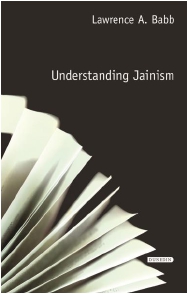 Book Review
Book Review
Lawrence A. Babb,
Understanding Jainism.
Edinburgh and London:
Dunedin Academic Press,
2015,
pp. xv + 182,
ISBN: 978-1-78046-535-7
(Pbk).
This short monograph is in the Dunedin ‘Understanding Faith’ series edited by Frank Whaling, and it provides a fresh, well-structured, clearly written account of Jainism that is appropriate for undergraduate students and interested general readers alike. Babb cleverly weaves together methodological and interpretive issues with the history of the Jains and a sketch of the religion as it is practised in the twenty-first century. The first chapter, ‘Charter’, opens with Mahavira’s life as presented in the Kalpasutra, a Shvetambara text. Babb notes the five events: conception, birth, renunciation, ‘attainment of omniscience and final liberation’ (p. 6).
The second chapter shifts to scholarly views of Jain history, revising the dates of his life (recorded by Digambaras as 582 - 510 BCE and Shvetambaras as 599 - 527) forward by a century, as he was a contemporary of Buddha, whose death was recently re-dated to 400 - 411 BCE. This chapter, ‘In History’, gives the context of the Vedas, and reactions to that religious and social order by Jains, Buddhists, Upanishadic sages, and now-extinct groups like Gosala’s Ajivikas. The roots of the Digambaras (nude, and strongest in the south) and the Shvetambaras (clothed, and strongest in the north of India) are investigated, and a detailed explanation of the differences between the two, particularly the scriptures each accepts, is given.
Chapter 3, ‘Liberation’s Roadmap’, covers Jain understanding of the soul, karma, and the stages of the spiritual life on the way to liberation.
Chapter 4, ‘Strivers’, discusses the rules that govern the lives of Jain mendicants - renunciation of sex and possessions, the avoidance of violence, lying, and theft - and the daily duties they perform, as well as the institutional structures that support them. Customs such as venerating deceased mendicants are described.
Chapter 5, ‘Supporters’, concerns the life of lay Jains, covering the ideal life found in the texts, the reality of affluent communities in contemporary India, devotional activities like temple visitation and the worship of images of the tirthankaras, the ritual calendar, and renunciation at the end of successful worldly lay life. The ethno-graphic detail in this chapter is excellent and assists to bring the religion to life for the reader, as does
Chapter 6, ‘A Moral Cosmos’, in which Babb analyses the ‘large and very complex body of knowledge about the nature of the cosmos, the earth and living things’ that Jains have developed (p. 105). Themes include space and time, the terrestrial world, and the fact that, as Babb says, ‘no human community has thought more deeply about the relationship between humans and other species than the Jains, and more strongly objected to harm inflicted on living things’ (p. 121). While this could be attractive for modern readers with ecological interests, Babb makes it clear that the Jain concern is primarily for the identity of the soul, rather than the identity of living things in the physical world.
Chapter 7, ‘Social Context’, opens with the fact that in the distant past Jainism was a ‘proselytising religion’ (p. 129), but now the Jains are a comparatively small community of 4.2 million or somewhat more, in teeming, Hindu-dominated India. Babb describes the operation of caste in Jain communities, which differs somewhat between north and south, and gives some information about three Jain castes: the Khandelvals in north India (mostly Digambara in Jaipur); the Osvals of Rajasthan and Gujurat, a mixed Hindu and Jain group; and the Shrimals, who are predominantly Shvetambara. This chapter ends with a short section on Jain relations with the state, which have often been fractious due to the religion’s radical ethic of no harm. The Afterword revisits the relationship of Jainism to Hinduism, and the ways in which the two traditions have ill-defined boundaries, for example, ‘the soteriology of the South Indian “Hindu” tradition known Śaiva Siddhānta is startlingly similar to Jainism’ (p. 150). To sum up, Babb has written an intelligent book that is a pleasure to read, and deserves a wide readership.
 Prof. Dr. Carole M. Cusack
Prof. Dr. Carole M. Cusack